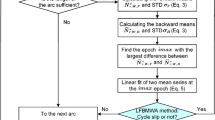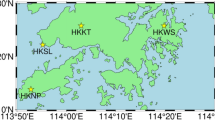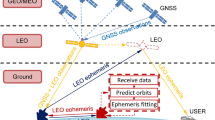Abstract
We investigate the feasibility of completing an aircraft precision approach using two global navigation satellite systems (GNSS) satellites from different constellations in combination with a stable frequency reference (SFR), barometric height and a radar altimeter. Before the start of two-satellite positioning, a full GNSS solution is used to calibrate the SFR and the vertical solution relative to the aircraft touchdown point. The theoretical clock and position error covariance is derived as a function of measurement error, satellite geometry, SFR stability, barometric height and radar altimeter performance. Detailed error models for each of the navigation sensors are developed for the covariance analysis. This is followed by both simulations and evaluations using flight test data to verify the positioning accuracy and the feasibility of completing an aircraft precision approach with only two satellites from different constellations. With respect to category I precision approach requirements of 16 m (95 %) horizontal and 4 m (95 %) vertical, the horizontal 95 % positioning performance is approximately 6 m, while the vertical 95 % positioning performance is approximately 4 m.














Similar content being viewed by others
References
Allan DW (1987) Time and frequency (time-domain) characterization, estimation, and prediction of precision clock and oscillators. IEEE Trans Ultrason Ferroelectr Freq Control 34(6):647–654. doi:10.1109/T-UFFC.1987.26997
Bridges PD (1988) Influence of satellite geometry, range, clock and altimeter errors on two-satellite GPS navigation. In: Proceedings of ION GPS 1988, Institute of Navigation, Colorado Springs, Colorado, September 19–23, pp 253–257
Brown RG (1984) Kalman filter modeling. In: Proceedings of 16th PTTI applications and planning meeting, Greenbelt, Maryland, November 27–29, pp 261–272
Brown AK (2005) GPS/INS uses low-cost MEMS IMU. IEEE AerospElectron Syst Mag 20(9):3–10. doi:10.1109/MAES.2005.1514768
Brown RG, Hwang PYC (1997) Introduction to random signals and applied Kalman filtering, 3rd edn. Wiley, New York
Brown A, Schmid T (1988) Integrity monitoring of the global positioning system using a barometric altimeter. In: Proceedings of ION NTM 1988, Institute of Navigation, Santa Barbara, California, January 26–29, pp 245–253
Chan FC, Pervan B (2009) Stochastic modeling of GPS receiver clocks for improved positioning and fault detection performance. In: Proceedings of ION GNSS 2009, Institute of Navigation, Savannah, Georgia, September 22–25, pp 1652–1665
Chen GT (1970) Introduction to linear system theory. Rinehart and Winston, New York
Cohenour C, Van Graas F (2013) GPS orbit and clock error distributions, 2005 to 2012. In: Proceedings of ION Pacific PNT 2013, Institute of Navigation, Honolulu, Hawaii, April 22–25, pp 946–958
Dayton RB, Nielson JT, Nolting RF (1988) Flight demonstration of two and three satellite navigation. In: Proceedings of ION GPS 1988, Institute of Navigation, Colorado Springs, Colorado, September 19–23, pp 259–266
Diggle DW (1994) An investigation into the use of satellite-based positioning systems for flight reference/autoland operations. Dissertation, Ohio University
Federation of American Scientists (2000) Digital terrain elevation data. http://www.fas.org/irp/program/core/dted.htm. Accessed 12 May 2014
GEAS (2010) Phase II of the GNSS evolutionary architecture study. Federal aviation administration, Feb 2010
Gelb A (ed) (1974) Applied optimal estimation. MIT Press, Cambridge
Gray R (1994) An integrated GPS/INS/baro and radar altimeter system for aircraft precision approach landings. Thesis, Air Force Institute of Technology
Hayashi N (1996) Low-cost sensor constraint GPS vehicle navigation in an urban environment. In: Proceedings of ION GPS 1996, Institute of Navigation, Kansas City, September, pp 1409–1417
Howe DA, Allan DW, Barnes JA (1981) Properties of signal sources and measurement methods. In: Proceedings of 35th annual frequency control symposium, IEEE, Philadelphia, Pennsylvania, May 27–29, pp 669-716
Huang J, Van Graas F (2007) Comparison of tropospheric decorrelation errors in the presence of severe weather conditions in different areas and over different baseline lengths. J Navig 54(3):207–226. doi:10.1002/j.2161-4296.2007.tb00405.x
ICAO (2012) Annex 10—Aeronautical telecommunications, vol I (Radio navigation aids). International civil aviation organization (ICAO), Amendment 87
IEEE (1999) IEEE Standard definitions of physical quantities for fundamental frequency and time metrology-random instabilities. IEEE Std 1139–1999:12–15
IS-GPS-200F (2011) NAVSTAR GPS space segment/navigation user interfaces, Interface specification IS-GPS-200. Air Force GPS Wing, Oct 25
Kayton M, Fried WR (1997) Avionics navigation systems, 2nd edn. Wiley, New York
Kline P (1998) Clock coasting using carrier phase measurements. In: Proceedings of ION NTM 1998, Institute of Navigation, San Diego, California, January 28–30, pp 611–623
Knable N, Kalafus RM (1984) Clock coasting and altimeter error analysis for GPS. J Navig 31(4):289–302. doi:10.1002/j.2161-4296.1984.tb00880.x
Lee YC (1993) RAIM availability for GPS augmented with barometric altimeter aiding and clock coasting. J Navig 40(2):179–198. doi:10.1002/j.2161-4296.1993.tb02303.x
Misra P, Enge P (2011) Global positioning system: signals, measurements, and performance, 2nd edn. Ganga-Jamuna Press, Lincoln
Murphy J, Skidmore T (1994) A low-cost atomic clock: impact on the national airspace and GNSS availability. In: Proceedings of ION GPS 1994, Institute of Navigation, Salt Lake City, Utah, September 20–23, pp 1329–1336
Ramlall R, Streter J, Schnecker JF (2011) Three satellite navigation in an urban canyon using a chip-scale atomic clock. In: Proceedings of ION GNSS 2011, Institute of Navigation, Portland, Oregon, September 20–23, pp 2937–2945
Studenny J (1995) Baro-altimeter calibration for GPS integrity. RTCA paper no 235-95/SC159-639, Washington
Sturza MA (1983) GPS navigation using three satellites and a precise clock. J Navig 30(2):122–132. doi:10.1002/j.2161-4296.1983.tb00831.x
Van Dierendonck AJ, McGraw JB, Brown RG (1984) Relationship between Allan variances and Kalman filter parameters. In: Proceedings of 16th PTTI applications and planning meeting, Greenbelt, Maryland, November 27–29, pp 273–293
Van Graas F, Soloviev A (2004) Precise velocity estimation using a stand-alone GPS receiver. J Navig 51(4):283–292. doi:10.1002/j.2161-4296.2004.tb00359.x
Van Graas F, Craig S, Pelgrum W, Ugazio S (2013) Laboratory and flight test analysis of rubidium frequency reference performance. J Navig 60(2):123–131. doi:10.1002/navi.34
Zhang Z (1997) Integration of GPS with a Rubidium clock and a barometer for land vehicle navigation. In: Proceedings of ION GPS 1997, Institute of Navigation, Kansas City, Missouri, September 16–19, pp 801–806
Author information
Authors and Affiliations
Corresponding author
Rights and permissions
About this article
Cite this article
Yen, SW., van Graas, F. & de Haag, M.U. Positioning with two satellites and known receiver clock, barometric pressure and radar elevation. GPS Solut 20, 885–899 (2016). https://doi.org/10.1007/s10291-015-0497-6
Received:
Accepted:
Published:
Issue Date:
DOI: https://doi.org/10.1007/s10291-015-0497-6




